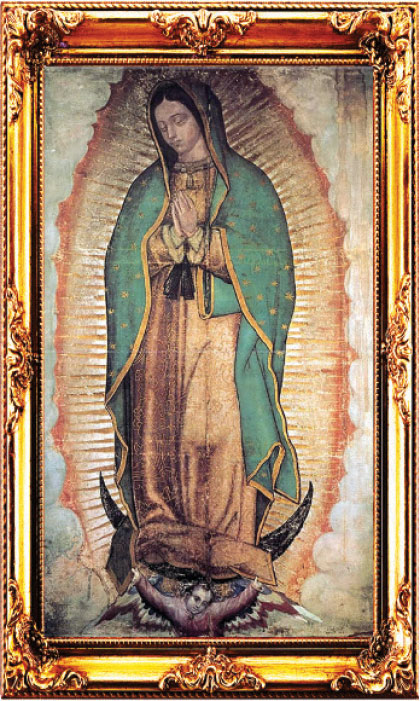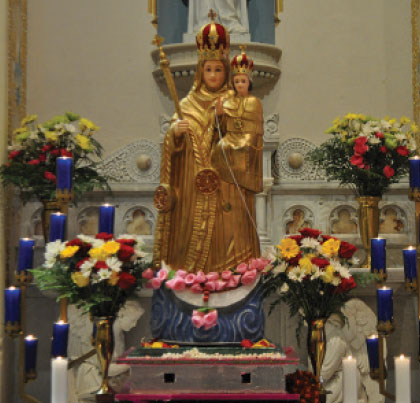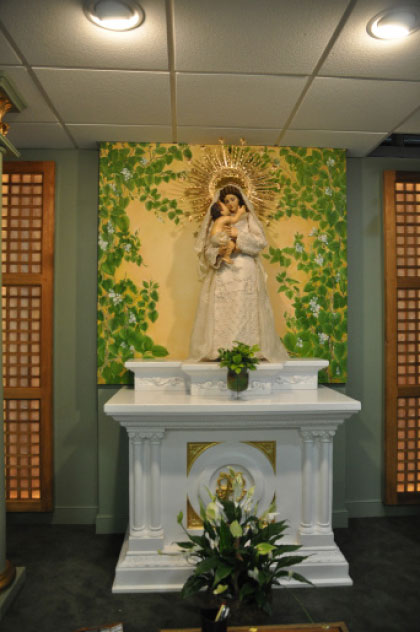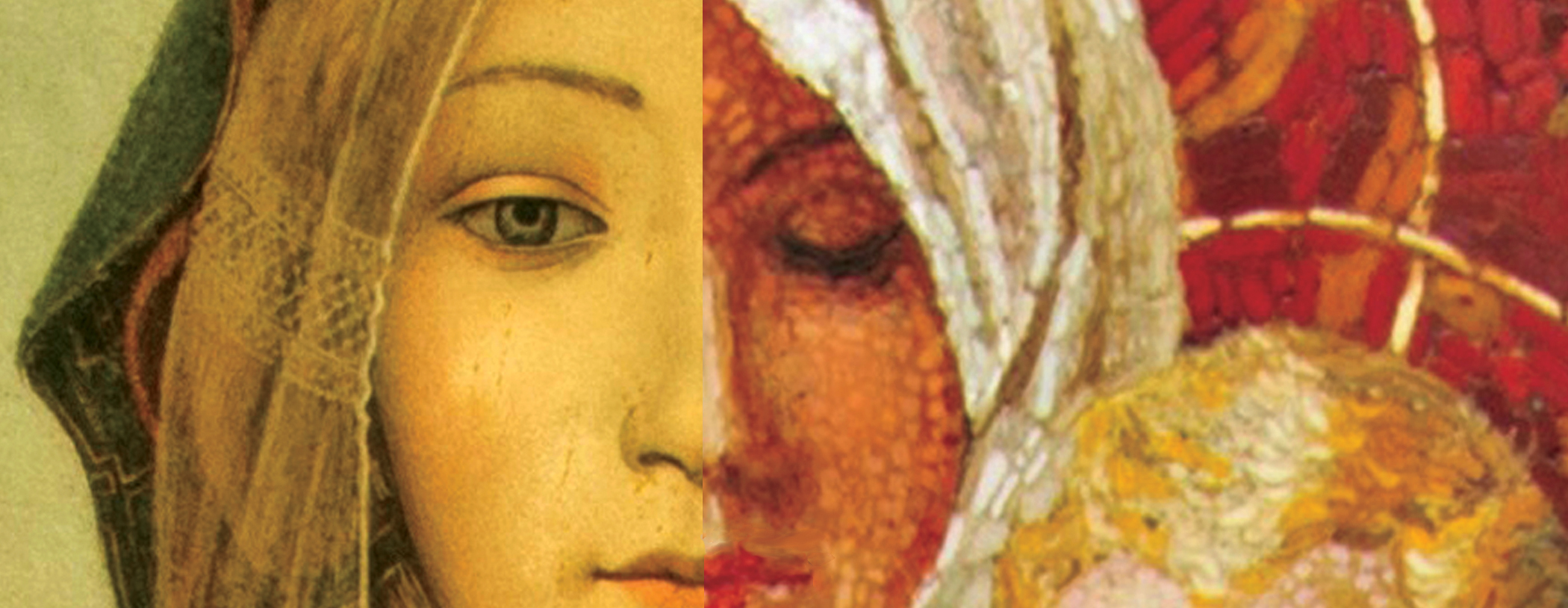The Many Faces of Mary
As a first-century Jewish woman, her features and clothing were indicative of that era. Yet, in her numerous appearances to us, the ways in which she communicates with us, and how she presents herself to us, differ from country to country and region to region. In a sense, she transcends time and culture, immersing herself in our world, while helping us to become immersed in hers. What is it about Mary that is so attractive and surpasses the distinctiveness of each culture? Does she bring something to the places in which she appears? Or do the places bring something to her?
Maybe it’s a combination of both.
Shaping and Being Shaped
Fr. Robert Maloney, CM, has lived in the United States, Italy, and Panama, and is captivated by Mary’s portrayal in art, literature, and music. He explains that throughout history, Biblical revelation and the traditions of our faith have helped shape our knowledge of Mary of Nazareth—as a mother, disciple, and role model. Illustrating his point, he notes that many renowned artists have painted at least one Madonna. Countless books have been written about her. And the songs about and prayers to her create an unending tide of veneration. In every century since Christ’s earthly life, these facets of culture have shaped how people practically apply Marian devotion to their lives. “The wonderful thing is that everyone is so attracted to her. Every country has an image of the Madonna that’s part of its culture,” he states.
Fr. Patrick Griffin, CM, who also lived in Europe, concurs. “Mary brings her values, shows us things in a way we understand, and we give her a flavor to the specifics of our culture.” In this loving exchange, we collectively shape the way she is portrayed, and she spiritually shapes us in the things that truly matter.
One of Us
Our Blessed Mother lived fully the human experience. Fr. Maloney notes, “Mary suffered from cold and hunger, from uncertainty about her future, from the death of her husband, and from the torture and death of her Son. When we’re suffering, she understands and identifies with us—and us with her.” Through the circumstances of daily life, “she shows us a way of relating to God, to one another, to suffering and death, and to resurrection. We’re attracted to her because she’s one of us.”
When Fr. Griffin describes his experience as the Director General of the Daughters of Charity in Paris, he paints a picture that, like our Blessed Mother’s life, is both tender and sorrowful. “A lot of lonely people go to the Chapel of the Miraculous Medal in Paris,” he observes. “They’re going through emotional matters that make waking up in the mornings difficult.” So they turn to Mary, who consoles and strengthens them.
It’s a Mother Thing
In Scripture, Mary is presented as a mother and intercessor, and her maternal love is clearly one facet of our devotion and attraction. Fr. Griffin explains that throughout the New Testament, Mary shows what it is to be a mother: She gave her humanity to Jesus, nurtured Him, left her home to protect Him, and even forgave Him when He got lost in the temple. “The focus is on her motherhood,” he reflects. “There is no culture where mothers are not valued.” He pauses and then says, “It’s a mother thing.”
Chuck Levesque, Executive Director at Depaul USA, agrees. “Everyone has a biological mother, and mothers have a special role. Wherever you go, moms do the same thing: They look different and speak different languages, but they share commonalities.” Having worked in Albania and now in Chicago within the homeless sector, he’s seen motherhood through the lens of different religions and cultures. It’s shown him the effects that losing a mother can have. “For someone on the verge of homelessness,” he comments, “losing a mother can create a chain reaction that spirals quickly to losing work and losing hope.”
While some people have neither positive nor strong relationships with their mothers, they can have one with Mary. “We can all agree that a mother should love her child,” Fr. Griffin states. “For the person who has not had that experience, Mary offers it. She does love you. You can speak to her; she will listen. Mary is that kind of a mother.”
She Brings Jesus
Mary is also presented in Scripture as an intercessor—one who, like Queen Esther, presents us and our needs before the throne of God. Of course, this implies that she listens to us. Fr. Maloney describes Mary as the perfect disciple, and discipleship is primarily listening and acting on what is heard. Mary spent most of her life listening—to God and to those around her—and she continues to do that. She listens to us, presents our needs to her Son, and then acts on His response. Through her hands, we receive God’s graces. As Fr. Griffin points out, “Mary doesn’t give us anything; she intercedes for us.” Through her intercession, she brings us to Jesus. And through her hands, she brings Jesus and His blessings to us.
Enshrined in our Hearts
Throughout the centuries, Mary has indeed, blessed us, her children, by coming to our world in times of trial. There are copious reports of her apparitions, and while many share similar characteristics, there are a few that are quite distinctive. In the lower level of The Miraculous Medal Shrine are three smaller shrines, each of which is wonderfully unique among Marian apparitions—and a fourth is in development.
 Our Lady of Guadalupe
Our Lady of Guadalupe
The Latino community has always had a special devotion to our Blessed Mother. This devotion dates back to 1531, when Mary appeared to Juan Diego, a 57-year-old indigenous farmer, as he was walking to Mass. Our Blessed Mother told him to build a church on that spot, so, as she directed, he went to the bishop. But the bishop didn’t believe him and asked for proof of his story. The next day, Juan returned to the hill and found Castilian roses in bloom—unusual for December. He gathered the roses in his tilma (a cloak made of cactus fiber) and held them close to his chest, exactly as Mary instructed. When he reached the bishop and opened his cloak, the beautiful roses fell out. To the astonishment of everyone present, the tilma bore a beautiful image of the Blessed Mother. Like the Miraculous Medal, the image was given directly from heaven, and it was uniquely filled with symbols familiar to the Aztec people. Over the centuries, it has formed the identity of millions of Latinos, and the miracles around it continue to flourish. Just ask Guadalupe Da Costa Montesinos.
“My mom named me after Our Lady of Guadalupe as a way of saying ‘thank you’ for protecting me during her pregnancy,” Guadalupe says. “When she was pregnant, she not only developed a kidney infection, but the umbilical cord was wrapped around my neck at birth. My mom told me I was blue when I was born.” Although she lost a fair amount of oxygen from that complication, she was born a perfectly healthy baby.
Guadalupe, too, has received miraculous help from Mary. “I had great difficulty becoming pregnant,” she says. “The doctors told me that I would never be able to conceive. So, my husband and I prayed to Our Lady of Guadalupe, asking for her intercession. After waiting and praying for ten years, I finally got pregnant.” Guadalupe’s daughter is also named Guadalupe, in honor of our Blessed Mother’s miraculous help.
In 2019, the Shrine honored Our Lady of Guadalupe with an original oil painting by Jose Gerardo Rico, which was commissioned and paid for by the Latino community and placed in the shrine of Our Lady of Guadalupe in the Lower Shrine. For the past twenty years, the community has felt at home in the Shrine now that they have a special place to pray to Our Lady of Guadalupe, a symbol of their identity and faith.
“The Latino culture is collectivist,” Guadalupe says. “We like to do things together as a group.” Once a month, morning and evening Spanish Masses are celebrated. “This makes a huge difference in our lives, because we are able to understand the homily, the readings, and the Mass itself,” explains Guadalupe, “and we can interact with other Spanish-speaking people. The homilies always revolve around Mary and her example—and encourage us to go to Jesus through her.” After Mass, the community gathers in the Lower Shrine “to share our testimonies and a light lunch.” The entire day is a visible witness of their love for Mary.
For event information for Spanish Masses, Our Lady of FIAT celebrations, and Vailankanni celebrations contact Colleen Buckley, cbuckley@cammonline.org. For information on Our Lady of Knock, contact Megan Brogan at 800.523.3674.
 Our Lady of Vailankanni
Our Lady of Vailankanni
South India has an impressive Catholic history. It dates back to the communities that St. Thomas the Apostle founded when he reached the present state of Kerala in 52 AD. Steeped in their faith for generations, Catholics lived their beliefs visibly with statues, images, and shrines of the Blessed Mother, Infant Jesus, and Sacred Heart dotting the landscape.
Our Blessed Mother rewarded their faith, appearing first in spring of 335 AD and twice in the 16th century. In her two latter appearances, Mary was carrying her Son, and both times she came to a young boy and asked him for milk for her Child. In her second appearance, Mary also asked a young, crippled boy to tell one of the men to build a shrine on that spot in her honor. Surprisingly, the boy miraculously jumped up and delivered her message. Recognizing the miracle, the man built a small wooden structure as she requested.
Approximately fifty years later, a Portuguese ship was in the Bay of Bengal when a fierce storm hit. The sailors prayed to the Blessed Mother for protection and promised they would build a chapel if she saved them. The storm ceased, and the ship landed at a shore near Vailankanni. When the sailors disembarked, they found the wooden structure, and constructed a beautiful stone chapel in its place. The people in Kerala have flocked to Mary’s shrine in Vailankanni, Our Lady of Good Health, ever since.
Interestingly, Vailankanni is the only known apparition where Mary requested milk for her Child. As the young boys eagerly responded by giving her their buckets of milk, Mary returned God’s divine graces to that spot and to everyone who humbly prays for her assistance. Jose Thomas can attest to that.
Jose and his family began coming to the Shrine eight years ago when their newborn son, Immanuel, was admitted to the Neonatal Intensive Care Unit of the Children’s Hospital of Philadelphia. While in the hospital, one of the nurses blessed the baby with a Miraculous Medal. That simple act prompted the family to visit the Shrine. Raised in deeply religious homes, Jose and his wife knew the power of the Blessed Mother, so they began attending the Monday Novenas regularly and pleading for Mary’s intercession. One afternoon, Jose saw a sign in the Lower Shrine asking for financial assistance in completing the Shrine of Our Lady of Good Health Vailankanni. He immediately promised the Blessed Virgin to help bring that ancient Indian devotion to American soil.
He contacted the Shrine to see how much money was needed to finish the project, and then reached out to his friends, family, and fellow parishioners. Each and every one of them responded—with greater contributions than Jose had requested. There were minor setbacks, but he persevered in his mission and invoked the assistance of Fr. John Melepuram, a great Marian devotee and then Vicar of St. Thomas Syro-Malabar Catholic Forane Church in Northeast Philadelphia. Through the tremendous contributions of the entire Indian community, a statue was made in India and shipped to the Shrine in Philadelphia; a special niche was built to house it; and a Solemn Mass of Inauguration and Rosary Procession were held. Approximately 800 people from the tri-state area attended. And within two years, Immanuel, who had severe heart issues and needed a transplant, had been miraculously healed. The doctors were stunned and called it an “act of God.” But Jose and his wife weren’t surprised. “Our devotion to the Blessed Mother has only become stronger,” he states. He is not alone in that sentiment.
 Our Lady of FIAT
Our Lady of FIAT
A priest from the Philippines once said that if you want to understand Filipino Catholics, you need to understand their love for Mary. Part of that can be attributed to their strong sense of family, where affection toward their own mothers is so important. It’s natural to consider “Mama Mary” (as Filipinos lovingly address her) as their spiritual mother. Mary’s faith in God and her “Fiat”—her humble obedience to God’s will—is another source of devotion and inspiration.
A group of Filipino-Americans in Philadelphia took Mary’s “Fiat” to be their association’s name: Filipinos in America Today (FIAT). FIAT’s inception was the outgrowth of a Life in the Spirit Seminar that began in the parish of St. John Chrysostom in Wallingford, Pennsylvania, in 1993. To “keep the fire burning,” they held weekly Bible Studies, annual retreats, and monthly Healing Masses with Adoration every First Friday. Their spirituality is decidedly Marian-humble obedience to God’s will and caring for those in need.
Along with outreach to a poor urban community in Malabon, Philippines, FIAT banded together under Fr. Efren Esmilla, current pastor at Our Lady of Hope in Philadelphia, to build the Shrine of Our Lady of FIAT. This shrine is a sacred space of prayer where “our Blessed Mother keeps all these things in her heart.”
Ruby Kirkup has experienced Mary’s love first-hand. Her mother had a great devotion to the Blessed Mother and the Miraculous Medal, and that love was embedded in Ruby, as well. When Ruby’s daughter was pregnant, she discovered she had a disease of the placenta, and the twin boys she was carrying might not live. Ruby visited various shrines in Philadelphia, and when she came to the Shrine, she prayed to Mary to intercede for her grandsons. Both boys were premature, but, defying the negative prognosis, they were alive and had no irreparable health conditions. Since then, Ruby has been a regular at the Shrine, and when she learned about the new shrine to Our Lady of FIAT, she felt compelled to act. “We’re drawn to our devotions,” she says, “I totally believe that.”
Click here to learn more about Our Lady of FIAT.
 Our Lady of Knock
Our Lady of Knock
The Irish first arrived in Philadelphia before the Revolutionary War. William Penn, himself, had ties to Ireland; Benjamin Franklin had visited the country in 1771; and eight of the Declaration of Independence signatories were of Irish descent. Almost a century later, the Great Hunger ushered tens of thousands to the City of Brotherly Love. They brought with them a steadfast faith, for which they had been persecuted for more than 300 years, and a deep devotion to Mary. When they settled in Germantown, they helped build the chapel now known as The Miraculous Medal Shrine. The Shrine was a gathering place for this community, a place where people could come and hear news about home. A place where they found comfort in the Blessed Mother’s presence.
Her presence was not a metaphorical one to the Catholics who were still in Ireland in 1879. In her apparition at Knock, Mary appeared next to a small, stone church in an impoverished area of County Mayo. With her were St. John the Baptist, St. Joseph, and the Lamb of God, standing on an altar surrounded by adoring angels. It was a rainy night, yet the water didn’t touch the heavenly visitors or the ground beneath them—even though the visions stood a few feet above the earth. Not a word was spoken, making this apparition exceptional. Words weren’t needed. Comfort was. And that’s what flowed from the apparition: peace, consolation, and hope. In the two hours that passed, more than twenty people witnessed this event.
Jim Dowling, a second generation Irish Philadelphian, laments that while there have been more than 300 miraculous cures recorded at Knock, it isn’t as well-known as Fatima and Lourdes. But in the tri-state area, many of the Irish are once again coming together at the Shrine to share their love for their homeland, their faith, and their devotion to Mary. As she appeared tangibly to their forefathers to comfort them, they’re creating something tangible to honor her, who continues to comfort her children. Now, a shrine to Our Lady of Knock is in development at the Shrine.
Visit miraculousmedal.org/support-knock to learn more about Our Lady of Knock Shrine.
Mary’s Symbol
When Mary visited St. Catherine Labouré, she brought with her a gift from heaven: the Miraculous Medal. Much like in Mexico of 1531, Mary left a physical remembrance of God’s love for us. Fr. Griffin reminds us that the period in which Mary appeared to St. Catherine was the second wave of the revolution. Not only were people dying due to war and hunger, plagues were devastating the population, as well. People started attaching this newly created Medal to the pillows of people who were suffering from the plague—and many of them were healed. It was from experiences like this that the Medal became known as the Miraculous Medal.
Our world still needs the peace and love that God offers. He doesn’t withdraw His graces, so the Miraculous Medal is just as powerful today as it was then. It’s not a lucky charm that can be worn without faith; it’s a reminder of His tender love for each us individually and Mary’s gentle care and guidance. Whether we turn to Mary as Our Lady of the Miraculous Medal, Our Lady of FIAT, Our Lady of Guadalupe, Our Lady of Knock, or Our Lady of Vailankanni, if we turn to her in deep prayer, wear her Miraculous Medal with confidence, and live a sacramental and selfless life.



